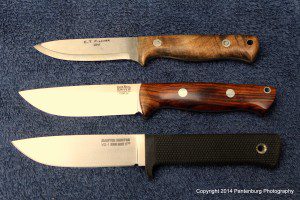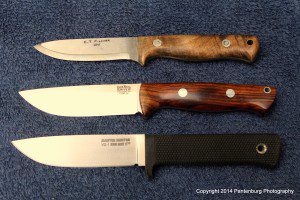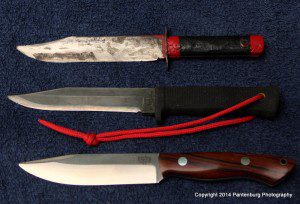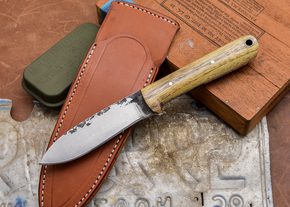
A crucial consideration for your survival knife is the design. The point will identify a few of the uses, and how effective the blade will be at different tasks. Here are some things to consider about point styles.
by Leon Pantenburg
Knife points, or tips, been available in every configuration under the sun, and you can get what ever you want. So when newcomers ask for suggestions on blade styles, there truly is no finest option.
However the point is a truly vital part of the blade style, and it will assist determine how efficient the knife is. A butcher needs a different point on his knife than a flooring installer does. An upswept skinner point most likely won’t work all that well for wood sculpting. And a knife for filleting fish will need a different point than a combating knife.
So prior to you purchase any flatware, here are a couple of factors to consider:
- What is the blade going to be utilized for? A great hunting knife, with a stiff, four-to-six-inch blade, is not the very best choice for a fishing knife. You can’t fillet fish all that well with a hunting knife, and a thin flexible filleting knife would not be the my option for gutting an elk. Neither is the very best choice for wood sculpting, where you might require a two-inch blade with a four-inch handle. Decide what you’re most likely to need the knife for.
- Reliability: It goes without stating that any knife related to the outdoors need to be dependable and a strong, hard tool. However in a metropolitan setting, the best survival knife choice may be a little penknife on a key chain. Either knife should have top quality steel and a tough manage.
- Alleviate of bring: A knife that is not convenient to bring gets left behind. Make certain that whatever knife you get comes in handy to load.
So that brings us to the point (pun planned!) For my individual hunting/fishing/survival/ everyday requirements, I have actually narrowed point choice to a few choices.

A drop point is an excellent choice for a multi-purpose knife. From top: C.T. Fischer Four-Inch Bushcraft knife, Bark River Bravo LT and Cold Steel Master Hunter. Drop: Here’s a meaning of a drop point:”The back (unsharpened) edge of the knife runs straight from the deal with to the tip of the knife in a sluggish curved manner, producing a lowered point.
“This decreased point provides more control and adds strength to the idea. While the tip on a drop point is not as sharp as the tip on a clip point, it is much more powerful. Since of this pointer strength and the ability to hold up to heavy usage, drop point blades are popular on tactical and survival knives.”– Steve Musumeche, Knife Depot (Read the whole story here.)
I truly like the drop points on my Cold Steel Master Hunter, Bark River Bravo LT and C.T. Fischer four-inch Bushcraft knives. I find it to be a good well-rounded choice.
Clip: The clip is truly a variation of the drop point, and is typically connected with Bowie knives.

Clip points are an excellent general option for a survival knife. From top: my very first knife, Cold Steel SRK and Bark River Sahara. The very first knife I made has a six-inch clip point blade. I was about 13 at the time, and from my reading, and various TV programs, had identified that a clip point would be the very best choice for searching in Iowa. Pertain to learn, the blade was way too huge for processing little video game animals, and I wound up using my Stockman design pocket knife for almost whatever.
However I used a Buck folding hunter with a clip point for deer searching for years. It has the best combination of upswept point for gutting, and enough stomach on the blade to be a great skinning knife. When I changed my dependable Buck with a survival knife, I got a Cold Steel SRK with a clip point.

This Lon Humphrey custom-made Kephart knife functions a spear point.(KnivesShipFree.com image)Spear: This point is right in the middle of the blade
, hence the name. It is a really typical point on broadswords or stabbing weapons, but is likewise helpful for a survival knife. There suffices stubborn belly to make it a satisfactory skinner, and the point is another excellent all-around option. As a weapon point, this might be the very best choice. It make a good choice for thrusting and slashing, and in basic, anything you ‘d require a fighting knife for. My Boy Scout knife, and the legendary Kephart pattern bushcraft knife have spear points, and they are great well-rounded cutlery options. Here is another point worth considering if a fighting knife becomes part of
your gear preparations: This Benchmade Griptilian functions a tanto point(KnivesShipFree.com picture
)TANTO: The two Samurai swords my father brought back from the Pacific in World War 2 have tanto points. The majority of tantos on the American flatware market are Americanized formats, according to Benchmade knives. Like the Japanese tanto, the Americanized tanto has a peak in-line with the pivot.
A flat grind is applied to the point, leaving it really thick and extraordinarily strong. This thick area helps soak upthe impact from piercing, as the tanto was originally developed for armor piercing. The front edge fulfills the bottom edge at an obtuse angle rather than curving to fulfill it as seen in
the Japanese tanto. A negative element of the tanto blade shape is the cutting area is sacrificed to gain idea strength. My long-time favorite is the clip point. But I have lots of designs of knife styles, and depending upon the job at hand, any of them, in a particular situation, might be the best option. As constantly, bear in mind that ANY piece of survival equipment has to
work for you. Research and invest appropriately. Please click here to have a look at and sign up for the SurvivalCommonSense.com YouTube channel– thanks! Amazon.com Widgets

